As the Nakdonggang river winds its way through North Gyeongsang Province, nestled in one of its curves is a picturesque place called Andong Hahoe Folk Village (하회마을).
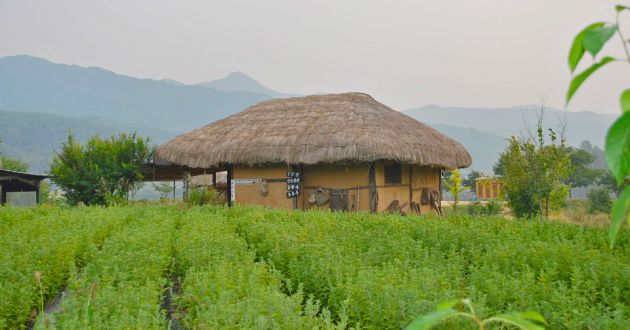
Designated “Important Folklore Material No. 122” by the Korean government, Andong Hahoe Folk Village is where members of the Pungsan Ryu family have lived for many generations.
“Hahoe” means winding river, and the scenic combination of the river and Taebaeksan mountains mean the village is located in an auspicious location. Some say Andong Hahoe Folk Village is like a lotus floating on the water.
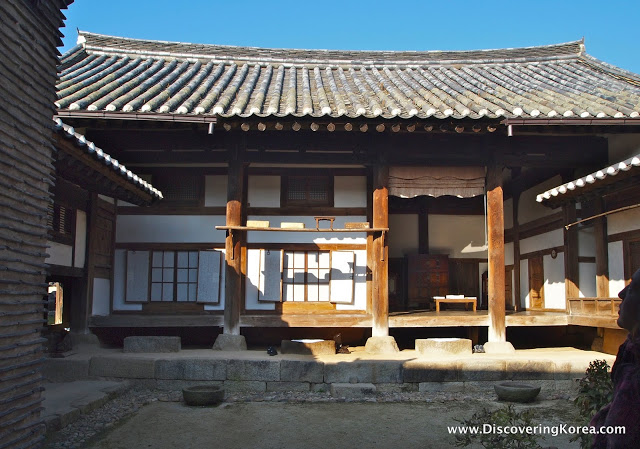
The area is a well-preserved example of a typical clan village from the Joseon Dynasty days. But what’s unusual about Hahoe is how the aristocratic yangban class and commoners lived together. The largest homes are located at the center of the village, which is divided by a road stretching northeast and southwest.
Historically, the main thoroughfare divided the Ryu clan’s primary and secondary branches. For example, the head house of the Ryu clan, known as Yangjindang (양진당), is located in the north section, and today is home to the family’s 14th direct descendant.
The village’s south section, however, includes Chunghyodang Manor (충효당), which is designated Treasure #414, and remains home to descendants of Ru Song-nyong, a 16th-century scholar and prime minister. Today, members of both branches live together throughout the village.
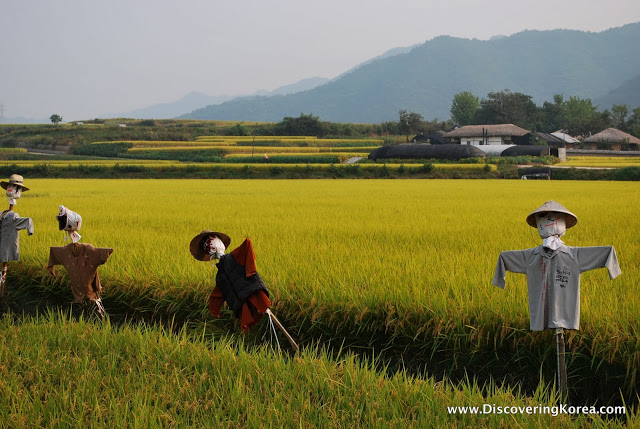
Circling around the stately homes are more modest ones. And unlike most villages, they face in all directions from the center, not only southward. These commoner dwellings typically feature thatched roofs instead of the traditional tile roofs of hanok-style homes.
While wandering along the narrow roads, it was clear that fall was on the way. The rice paddies had gone from a vibrant green to an almost fluorescent yellow.
Among the village homes, I saw signs on some that offered tea, meals or even overnight stays. And yet, the place, while very popular with tourists on the weekends, didn’t feel overly commercialized.
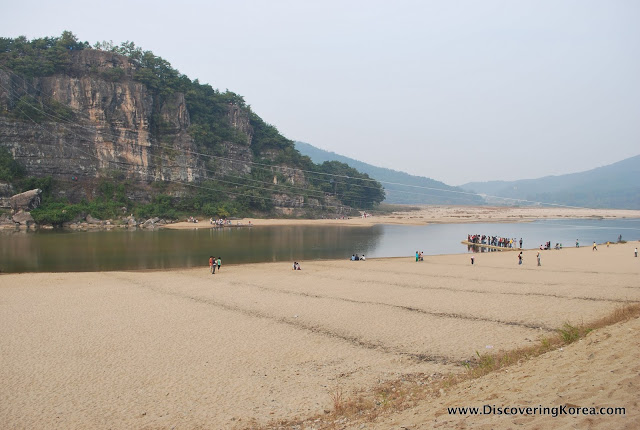
Another striking topographical feature of Andong Hahoe Folk Village is the cliff that rises 64-meters above sea level. Located against one of the river’s bends, it’s known as Buyongdae.
In Joseon times, the ruling class would conduct a poetry meeting in front of the cliffs as julbulnori (줄불놀이), a traditional fireworks display would pop and crack above them. During my visit, a long canoe was ferrying people across the river to hike the cliff and enjoy the views.
Long strings of fireworks ran from the village beach high up to the cliff, and shortly after sundown, they lit up the night sky.
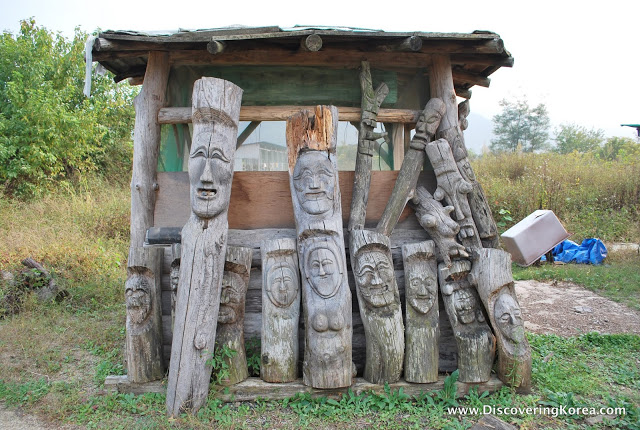
Andong Hahoe Folk Village is also well known for its role in preserving Korea’s folk heritage. At its entrance are several jangseung (장승), which resemble North American totem poles.
These carved wooden statues guard against misfortune by appeasing the air and earth spirits. But Hahoe is probably best known for its dramatic mask dance and shamanistic rituals called Hahoe byeolsingut talnori (하회 별신굿 탈놀이).
The dances were one way the common people could satirize the arrogance of the ruling class. If masks are your thing, then check out the Hahoe Mask Museum, which features hundreds of masks from Korea and around the world.
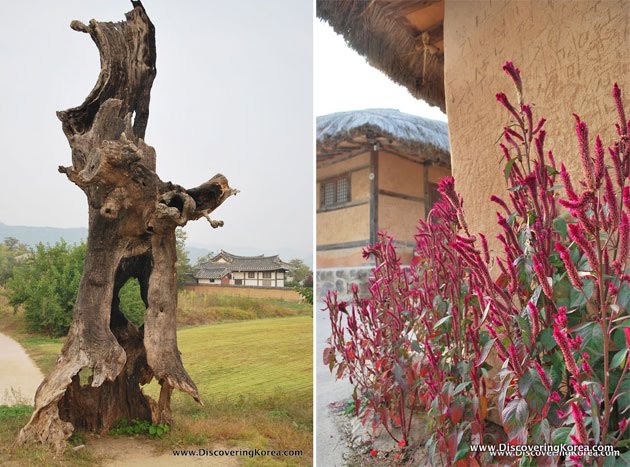
And, finally, back in the day, the mask dances would occur under an old zelkova tree. There are three major shrines in Andong Hahoe Folk Village, and the tree is home to the village spirit. Over 600 years old, at the tree’s base is where residents still pray for the health and success of their village.
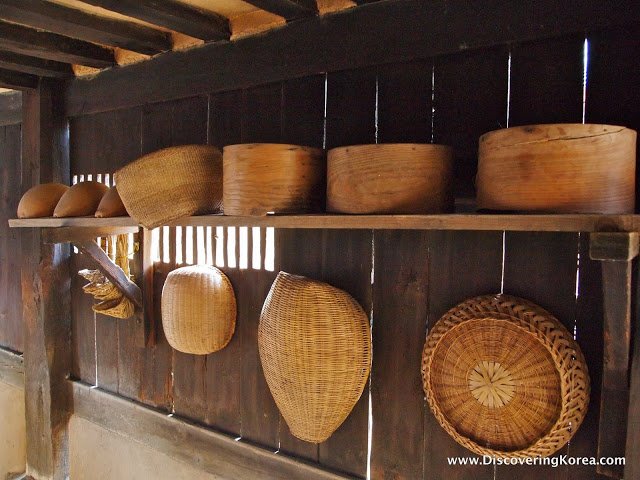
The greater Andong area features several amazing cultural properties that shouldn’t be missed, including Dosan Seowon Confucian Academy (도산서원).
For Your Information..
| Open: | Mar-Oct: 09:00-19:00; Nov-Feb: 09:00-18:00 |
| Admission Price: | ₩2,000 Adults, ₩1,000 Youth, ₩700 Children; Parking: ₩2~4,000 |
| Address: | North Gyeongsang Province Andong-si Pungcheon-myeon, Jongga-gil 40 |
| Directions: | From Andong Bus Terminal, take bus #46 to Hahoe Village (runs 10x daily) |
| Phone: | 02-1330 |
| Website: | Official Site |
About Matt Kelley
Matt Kelly is native of the US Pacific Northwest and is half-Korean by ethnicity. He lived in Korea for five years and has written hundreds of travel guides for Wallpaper, TimeOut, the Boston Globe and Seoul Magazine and was a host for several different variety shows on Korean radio and television.
